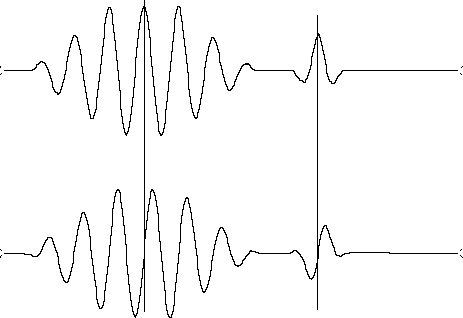Beginning with a causal response, we switched cosines and sines in the frequency domain. Here we do so again, except that we interchange the time and frequency domains, getting a more physical interpretation.
A filter that converts sines into cosines is called a ``![]() phase-shift filter" or a
``quadrature filter."
phase-shift filter" or a
``quadrature filter."
More specifically,
if the input is ![]() ,then the output should be
,then the output should be ![]() .An example is given in Figure 2.
.An example is given in Figure 2.
|
hilb0
Figure 2 Input (top) filtered [2] with quadrature filter yields [4] phase-shifted signal (bottom). |  |
Let U(Z) denote the Z-transform of a real signal input and Q(Z) denote a quadrature filter. Then the output signal is
| |
(5) |
Let us find the numerical values of qt.
The time-derivative operation
has the ![]() phase-shifting property we need.
The trouble with a differentiator
is that higher frequencies are amplified
with respect to lower frequencies.
Recall the FT and take its time derivative:
phase-shifting property we need.
The trouble with a differentiator
is that higher frequencies are amplified
with respect to lower frequencies.
Recall the FT and take its time derivative:
 |
(6) | |
| (7) |
| |
(8) |
 |
(9) | |
| (10) |
Since qn does not vanish for negative n, the quadrature filter is nonrealizable (that is, it requires future inputs to create its present output). If we were discussing signals in continuous time rather than sampled time, the filter would be of the form 1/t, a function that has a singularity at t=0 and whose integral over positive t is divergent. Convolution with the filter coefficients qn is therefore painful because the infinite sequence drops off slowly. Convolution with the filter qt is called ``Hilbert transformation."
 |